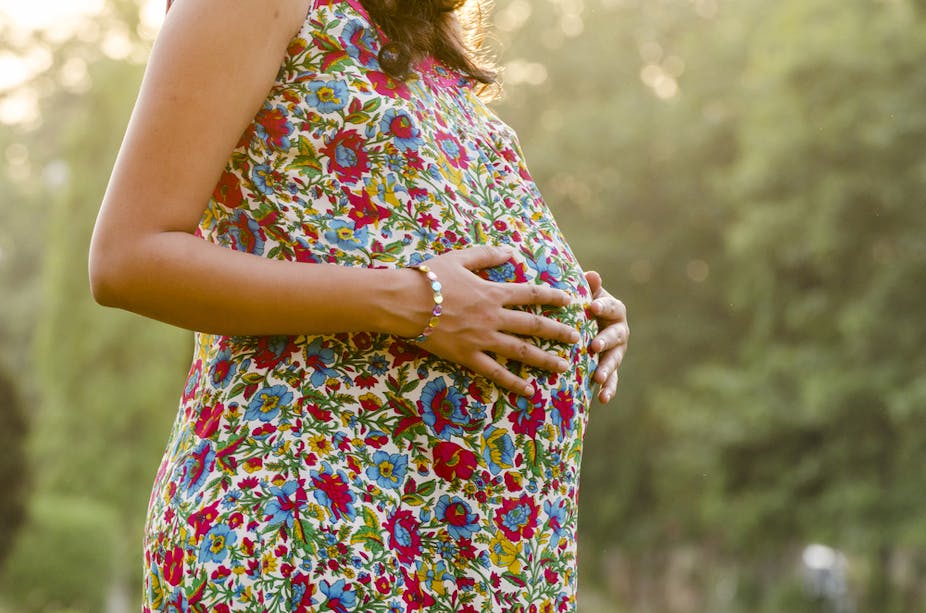For singles and couples who can’t naturally conceive and carry a baby to term, surrogacy is sometimes considered an option to have a child. Current laws across Australia permit “altruistic” surrogacy which prohibit the exchange of funds for surrogacy, beyond reasonable expenses, in order to protect the woman and child involved.
Some commentators argue these restrictions should be lifted to allow commercial surrogacy. This would involve a transaction between a commissioning person or couple and a woman, either directly or via a broker. So the woman carries and bears a child, and then permanently relinquishes it to the commissioning person or couple, in exchange for a fee.
But while advocates for commercial surrogacy in Australia present it as a workable solution to issues of global exploitation of women and children, if you look a little deeper it emerges as an ethically and legally fraught process. Australia should not join the ranks of Guatemala, India, Thailand, Russia, Georgia, the Ukraine and some US states which permit commercial surrogacy.
The market mentality
Commercial surrogacy advocates focus on payment for the surrogate’s “services”, using strong market-based language. Such market mentality preys on people’s vulnerabilities, and detracts from the realities involved.
Commissioning couples are sold the idea that commercial surrogacy is simply a business transaction that can be performed with ease. They are told they will achieve emotional fulfilment and a family of their own using commercial surrogates who are really giving, altruistic women, who want to help (for a fee or compensation).
The reality of commercial surrogacy paints a different picture. Concerns for women and children are minimised or ignored by brokers, lawyers, and others who stand to profit.
Sociological studies of surrogates suggest that commercial surrogates are susceptible to financial inducement and are vulnerable to exploitation because of their financial status. As US legal researcher Katherine Drabiak points out:
rhetoric that portrays the surrogate as a reasonably well-educated, financially stable woman motivated by altruism stands in contrast to reality.
This is so in both developing and developed countries.

Some proponents of commercial surrogacy argue that in order to prevent exploitation, surrogates should be paid a minimum amount to compensate them for the risk and burden they take. Allegedly the minimum payment will serve to avoid “unfair inducements”.
But who would act as a surrogate in such circumstances? It’s most likely to be women who are vulnerable or financially needy: low-income single mothers, migrants, unemployed women, or mothers unable to work and care for her children at the same time – enticed (or induced) by the minimum payment.
Perhaps what will follow is that we will be asked to believe that accepting low payments for commercial surrogacy reflects that surrogates are not really doing it for the money after all. Of course, such rhetoric keeps the price of commercial surrogacy down.
Note, while advocates of commercial surrogacy equate carrying a child with labour (work), they do not suggest that anywhere near the minimum wage be paid (24 hours a day for nine months at A$16/per hour = approximately A$107,000).
Finally, we can’t forget that the “marketisation” of birth involves a child. That child will perhaps one day be aware of the commercial transaction that surrounded his or her birth. The consequences of being handed over for “minimum” compensation are unknown.
Global commercial surrogacy
There is no doubt that in the global commercial surrogacy market, poor and vulnerable women have been trafficked for use as surrogates for the profit of agents or brokers.
Even in more “routine” cases, in both the developing and developed world, there are concerns about the extent to which women engaged as surrogates are influenced by social, cultural, and economic inequities.
This is not reason to bring commercial surrogacy to Australia. In fact, it should be reason not to do so.
Back in Australia, those who commission surrogates in commercial arrangements abroad must apply for legal parentage of these children. This is not always guaranteed. In such instances, our concern should lie with the welfare and best interests of the child, but this does not mean that legal parentage should be assured. Courts must scrutinise each individual case.
The law should not be changed because of people who have chosen to enter into, or facilitate, commercial surrogacy arrangements abroad – sometimes in contravention of Australian laws.
Protecting women and children
Australian states and territories need to preserve their current laws that serve to protect women and children by prohibiting commercial surrogacy, while permitting “altruistic” surrogacy in some circumstances. Everyone should be treated equally under such laws.
Australia also has an obligation to work to reduce the international commercial surrogacy trade. One option is to prohibit Australians from engaging in such arrangements abroad. But in doing so we must be careful to recognise the vulnerabilities of commissioning parents too. As such, we need also consider the actions of lawyers and other agencies who make a business (and handsome profit) out of giving “advice” to people about commercial surrogacy abroad, and who are pushing for its inception here.
Most importantly, Australia needs also to facilitate and support different family formations via other means, such as co-parenting arrangements, or foster-care and adoption when there is a child in need. We must recognise the desire some people feel to have children but commercial surrogacy should not be sold to them as a way to achieve such desire.

